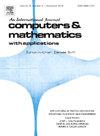边界元法求解具有出口边界条件的三维稳态Stokes流动问题
IF 2.5
2区 数学
Q1 MATHEMATICS, APPLIED
引用次数: 0
摘要
本文探讨了三维稳态斯托克斯流“出口”边界条件的边界元表达式。先前的一项研究已将其用于二维情况。目前的研究是该研究的自然延伸。具体来说,法向速度梯度指定为零或压力指定为任意值的边界现在可以在三维空间中处理。这将打开边界元法(BEM)的各种各样的斯托克斯流动问题。这两个边界条件的过程都是从在域内一小段距离处创建出口平面的副本开始的。积分项中相关数学量的离散化将导致生成包含上述边界条件的边界元方程。本文阐明了该过程的所有数学复杂性,特别是对于更重要的定压边界条件。本文的其余部分演示了迄今为止标准边界元程序无法解决的几个相对简单的斯托克斯流动问题的新边界条件。BEM的预测与现有的分析解非常吻合。文章最后提出了结束语和未来可能的研究方向。本文章由计算机程序翻译,如有差异,请以英文原文为准。
Solution of three-dimensional steady state Stokes flow problems with exit boundary conditions by the boundary element method
This paper explores the Boundary Element formulation of “exit” boundary conditions for three-dimensional steady state Stokes flows. A previous investigation had formulated it for two- dimensional situations. The current study is a natural extension of that research. Specifically, the boundaries that have the normal-velocity gradient specified as zero or that have the pressure specified as any value can now be tackled in three dimensions. This would open up the Boundary Element Method (BEM) to a wide variety of Stokes flow problems. The procedure for both the boundary conditions begins with the creation of a replica of the exit plane at a small distance inside the domain. A discretization of the relevant mathematical quantities within the integration terms would result in the generation of the BEM equations that would include the above boundary conditions. This paper articulates all the mathematical intricacies of the procedure, especially for the more important specified-pressure boundary condition. The remainder of this paper demonstrates the new boundary conditions for a couple of relatively simple Stokes flow problems that were hitherto unsolvable by the standard BEM procedure. The BEM predictions matched excellently with the available analytical solutions. The article rounds off with concluding statements and possible research directions in the future.
求助全文
通过发布文献求助,成功后即可免费获取论文全文。
去求助
来源期刊

Computers & Mathematics with Applications
工程技术-计算机:跨学科应用
CiteScore
5.10
自引率
10.30%
发文量
396
审稿时长
9.9 weeks
期刊介绍:
Computers & Mathematics with Applications provides a medium of exchange for those engaged in fields contributing to building successful simulations for science and engineering using Partial Differential Equations (PDEs).
 求助内容:
求助内容: 应助结果提醒方式:
应助结果提醒方式:


